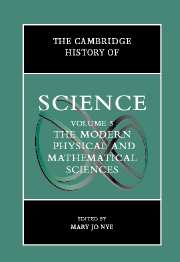Book contents
- Frontmatter
- Introduction: The Modern Physical and Mathematical Sciences
- Part I The Public Cultures of the Physical Sciences After 1800
- Part II Discipline Building in the Sciences: Places, Instruments, Communication
- Part III Chemistry and Physics: Problems Through the Early 1900s
- 11 The Physical Sciences in the Life Sciences
- 12 Chemical Atomism and Chemical Classification
- 13 The Theory of Chemical Structure and its Applications
- 14 Theories and Experiments on Radiation from Thomas Young to X Rays
- 15 Force, Energy, and Thermodynamics
- 16 Electrical Therory and Practice in the Nineteenth Century
- Part IV Atomic and Molecular Sciences in the Twentieth Century
- Part V Mathematics, Astronomy, and Cosmology Since the Eighteenth Century
- Part VI Problems and Promises at the End of the Twentieth Century
- Index
- References
11 - The Physical Sciences in the Life Sciences
from Part III - Chemistry and Physics: Problems Through the Early 1900s
Published online by Cambridge University Press: 28 March 2008
- Frontmatter
- Introduction: The Modern Physical and Mathematical Sciences
- Part I The Public Cultures of the Physical Sciences After 1800
- Part II Discipline Building in the Sciences: Places, Instruments, Communication
- Part III Chemistry and Physics: Problems Through the Early 1900s
- 11 The Physical Sciences in the Life Sciences
- 12 Chemical Atomism and Chemical Classification
- 13 The Theory of Chemical Structure and its Applications
- 14 Theories and Experiments on Radiation from Thomas Young to X Rays
- 15 Force, Energy, and Thermodynamics
- 16 Electrical Therory and Practice in the Nineteenth Century
- Part IV Atomic and Molecular Sciences in the Twentieth Century
- Part V Mathematics, Astronomy, and Cosmology Since the Eighteenth Century
- Part VI Problems and Promises at the End of the Twentieth Century
- Index
- References
Summary
The historical relations between the physical sciences and the life sciences have often been framed in terms of overarching conceptions about the nature of vital processes. Thus, in antiquity, the mechanistic viewpoint of the atomists, represented in physiological thought by the Alexandrian anatomist Erasistratus, is contrasted with the teleological foundations of Aristotle’s biology, defended in late antiquity by Galen. For the early modern period, the Aristotelian framework within which William Harvey (1578–1657) discovered the circulation of the blood is contrasted with the “mechanical conception of life,” introduced in the new “mechanical philosophy” of René Descartes (1596–1650), and a chemical conception of life, associated with the iconoclastic Renaissance physician Paracelsus (1493–1541).
For the nineteenth century, the cleavage between the “vitalist” views of physiologists early in the century and the “reductionist” views of physiologists coming of age in the 1840s, who aimed to reduce physiology to physics and chemistry, has been treated as the most significant turning point in the relation between the physical and biological sciences. The views of these, mainly German, physiologists are often compared with those of the most prominent French physiologist, Claude Bernard (1813–1878), who also opposed vitalism but believed, nevertheless, that life is something more than the physical-chemical manifestations through which it must be investigated.
- Type
- Chapter
- Information
- The Cambridge History of Science , pp. 217 - 236Publisher: Cambridge University PressPrint publication year: 2002



